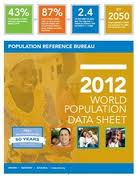Bridging the Demographic Divide and Other Population Challenges
Jul 19th, 2012 | By admin | Category: Family PlanningBy Suzanne York, www.howmany.org
Population Reference Bureau (PRB) just released its 2012 World Population Data Sheet, showing that the world’s poorest countries will have the greatest population growth, due to high birth rates and a large youth population. Just one week after the London Summit on Family Planning, which raised $2.6 billion from donors for improving women’s access to contraceptives, the information underscores the importance of investing in women’s reproductive health.
According to Carl Haub, PRB senior demographer and co-author of the data sheet, there are 25 countries in Africa where women have five or more children each. The population of Sub-Saharan Africa will likely reach 1 billion people by 2050. In contrast, Europe is predicted to be the first region to see long-term population decline, a result of low fertility rates. This is called the demographic divide, defined as:
A demographic divide is the vast gulf in birth and death rates among the world’s countries. On one side of this divide are mostly poor countries with relatively high birth rates and low life expectancies. On the other side are mostly wealthy countries with birth rates so low that population decline is all but guaranteed and where average life expectancy extends past age 75, creating rapidly aging populations.
PRB has an excellent chart depicting the demographic gap, comparing Tanzania and Spain. Tanzania’s population is expected to almost triple between now and 2050 (from 48 million to 138 million), while Spain will see an increase of just 2 million people during that time.
The total fertility rate, or average number of children per woman, is 2.4. worldwide, and 4.4 in the world’s poorest countries (and which are the target of the family planning conference in London).
Global support for improving access to voluntary family planning services is critical. There are over 220 million women in developing countries who want access to modern methods of birth control. The keys to empowering women in Tanzania and the world over is investing in family planning and reproductive health, supporting education and viable employment opportunities, improving gender equality, and addressing environmental impacts that affect women the most, from water scarcity to droughts to a changing climate.
As for the other side of the demographic divide, many questions are still to be answered, including how to provide for an aging population in the face of population decrease and how to cope with rising health care costs. And as far as the environment is concerned, how to deal with unsustainable rates of consumption. A declining population doesn’t necessarily equal a declining environmental impact. The developed world’s use of resources (and a rising middle class in such countries as China, India, and Brazil) and a global economic system based on infinite growth pose huge challenges for all.
With the London Summit now come and gone, and with it most of the media attention on family planning and women’s rights, the latest statistics from PRB reflect the need for continued action and investment. Women play a major role in providing for and taking care of not only their families but also their communities and environment. From Tanzania to Niger to Yemen, Spain and beyond, women’s voices must be heard and their needs addressed.
Above all, rights must be respected – for women, men, youth, and nature – and the divide narrowed, for a better future for people and the planet.
Suzanne York is a senior writer with the Institute for Population Studies/HowMany.org

